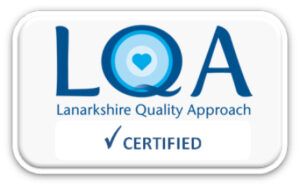About Induction of Labour
Information for patients
NHS Lanarkshire Maternity Department
PIL.INDLAB.17_10457.L
Section 1 – About Induction of Labour
What is Induction of Labour?
Induction of labour is a process used to encourage labour to start artificially.
In order for a baby to be born the cervix (the neck or opening to the uterus/womb) has to shorten, soften and open and there must be contractions.
In most pregnancies this starts naturally between 38 – 42 weeks and is called ‘spontaneous labour’.
If this doesn’t happen naturally there are a number of procedures/ techniques that can be used to encourage labour which are described in section 3 of this leaflet.
When might I be offered Induction of Labour?
There are three main reasons why induction of labour is offered:
- Prolonged pregnancy – once you are more than 42 weeks pregnant, there is an increased risk that your baby will be stillborn or have health problems. Normally after 41 weeks pregnancy, you will be given a date before 42 weeks to have your labour induced (normally 41 weeks +5 days)
- Pre labour rupture of membranes – (The waters around the baby breaking.) If spontaneous labour does not happen approximately 48 hours after the waters break there is a small risk of infection to the mother and/or the baby.
- Medical reasons – if your health, or your baby’s health is at increased risk if the pregnancy continues.
Can I choose not to be induced?
If you do not want to be induced you should tell your midwife or doctor. You will be offered an appointment to attend hospital so we can check you and baby are healthy to continue without induction.
How do I prepare for Induction of Labour?
Please read this information leaflet and share the information it contains with your partner and family (if you wish) so that they can be of help and support.
There may be information they need to know, especially if they are supporting you as the birth partner.
Wear clothes that you are comfortable in, you do not have to change into nightclothes unless you prefer to. Bring books, magazines and games to occupy yourself, as the procedure may take several days.
Membrane Sweep (stretch and sweep)
If your pregnancy is prolonged you will be offered a membrane sweep at around 41 weeks. This has been shown to increase the chances of labour starting naturally within 48 hours of the procedure, and can reduce the need for other methods of induction of labour.
A stretch and sweep is a vaginal examination that can be carried out at the clinic. The procedure involves the doctor or midwife putting a finger inside your cervix and making a circular sweeping movement to separate the membranes from the cervix. This increases the production of hormones called prostaglandins which can encourage labour to start.
There may be some discomfort or bleeding but it will not cause any harm to you or your baby. It will not increase the chance of you or your baby getting an infection.
Section 2 – Where will labour be induced?
Most women are admitted to Ward 23 to start the procedure.
Some will have to stay in hospital all the time during the procedure whilst other women may be able to go home (outpatient induction of labour).
If the waters around the baby can be broken straightaway or the waters around the baby have already broken, (pre-labour rupture
of membranes), you will be induced on the Labour Ward.
Outpatient Induction of Labour
What are the benefits?
An outpatient induction of labour:
- Allows you to stay at home which evidence has shown helps labour to progress as you are in a familiar place.
- Reduces the amount of time you need to be in hospital before your labour begins.
- Makes the process of induction more normal for you.
Who can have outpatient Induction of Labour?
Your midwife or doctor will assess if you are suitable for outpatient induction of labour and discuss this option with you.
You may be offered outpatient induction of labour if:
- Your pregnancy is ‘low risk’.
- You have no serious medical or pregnancy related problems.
- You have someone who will stay with you at home on that day.
- You have transport to bring you to the hospital and take you home.
Section 3 – Types of Induction of Labour
Types of Induction of Labour
There are different methods used to induce labour. You may need all, or just one of them depending on what your cervix is like at the start of the induction.
Artificial Rupture of the Membranes (ARM)
When the cervix is open to around two to three centimetres and the baby’s head has gone down into your pelvis, it should be possible to ‘break the waters’ around the baby.
This procedure is carried out by using a small plastic hook which releases the water and allows the pressure of the baby’s head to press on the cervix and stimulate contractions. It will not harm you or your baby. The procedure may be uncomfortable but it should not be painful.
Prostaglandin – Inpatient Induction
Prostaglandin is used when the cervix is not ready or ‘favourable’ to go into labour. It softens and opens the cervix enough to start labour, or, to be able to do an Artificial Rupture of Membranes (ARM).
For the IOL process will use prostin tablets we will perform a vaginal examination and administer these if the cervix is unfavourable this procedure will repeated six hourly and if the cervix remains unfavourable you may require up to three tablets.
Sometimes the neck of the womb might not be soft enough to allow the next stage of induction to proceed. If this is the case, the obstetrician will discuss your options with you. You may be advised to have a break from the procedure before continuing.
In both cases you and your baby will be monitored on a regular basis. In between monitoring you will be encouraged to walk about or use the ‘birthing balls’, as being active can help to encourage labour to start.
Cervical Ripening Balloon Catheter
The procedure involves a catheter which is similar to the one that is inserted into the urinary bladder except that this catheter is inserted into your cervix. It has a balloon near the tip and when it is in place the balloon is filled with a sterile fluid (saline). The catheter stays in for over 12 hours with the balloon putting gentle pressure on the cervix. The pressure should soften and open your cervix enough to start labour or to be able to break the waters around your baby (Artificial Rupture of Membranes). The balloon may fall out by itself or will be removed by a midwife.
This method, unlike the others does not require close monitoring, which is why it is the only method used for outpatient induction of labour.
Information for women going home after Cervical Ripening Balloon Catheter
During the time you are at home, you can do things as you would normally, for example, showering, bathing or walking. However, please avoid intercourse.
Please ring 01698 366210 if you have any:
- Bleeding
- Contractions
- Concerns about the baby’s movements
- Unable to pass urine spontaneously
Or: - You feel unwell
- The waters around the baby break
- The balloon falls out
A midwife will talk to you and assess if you need to come back into hospital.
If there are no concerns/problems you would return to Ward 23.
You will have the balloon removed and will be assessed to see if it is possible to do an ARM.
Oxytocin (Syntocinon)
This is an artificial form of the hormone that causes your uterus (womb) to startcontractions. This is given through a tiny tube into a vein in the arm (drip). It can only be given when the waters have broken. This is usually the main form of induction for pre-labour rupture of the membranes.
Although we try and induce labour following rupture of membranes and absent contractions, at busy times this may be delayed.
The drip is increased very slowly until your uterus is contracting regularly and strongly. Women respond differently to how well the drip works on contractions as it will depend on how ready your body is for the labour process.
Your baby’s heart rate will be monitored continuously by a cardiotocograph (CTG) during the labour. Your ability to walk around will be limited by the drip and monitor; you may choose to stand up, or sit on a chair or birthing ball.
Section 4 – Complications or risks
Cervical Ripening Balloon Catheter
The procedure can be uncomfortable but it should not be painful. There is a very small risk of infection. If an infection is suspected, your baby will need to be delivered by the quickest possible method.
Prostaglandin
Inserting the prostaglandin pessary can be uncomfortable. Prostaglandin can cause soreness in and around the vagina. It can also cause strong painful contractions; having these contractions does not always mean you are in labour. Your midwife will support you to to cope with this.
On rare occasions, prostaglandins can cause the uterus to contract too frequently and this may affect the pattern of your baby’s heart beat. This is usually treated by giving a drug that helps the uterus to relax. Sometimes the uterus continues to contract too frequently/strongly and an emergency caesarean section may be necessary.
Oxytocin (Syntocinon)
As with prostaglandin, the main risk is that the uterus can contract too strongly/frequently and affect the baby’s heartbeat. Reducing the rate of the oxytocin can have an immediate effect on easing the contractions which will improve the baby’s heartbeat. If the baby’s heartbeat does not recover, the senior doctors will decide with you what is required. ARM and the Syntocinon drip are procedures that can only be done on the Labour Ward.
You will be transferred as soon as it is possible but at busy times there is sometimes a delay.
The Labour Ward maternity team make decisions based on medical needs and the safety of you and your baby as well as the other expectant mum’s and babies in their care.
If you are being induced as an outpatient, this will not affect the decision about who and when to admit to Labour Ward.
Section 5 – Coming to hospital
What will happen?
When you are admitted to Ward 23 you will be shown the ward layout. The midwife caring for you will introduce themself, discuss the safest method to induce your labour with you and make sure you understand the procedure.
Please feel free to ask any questions or voice any concerns/anxieties, we are here to help at all times.
While you are on Ward 23 you can have one birth partner with you all the time between 9am – 9pm. If you have a second birth partner they can come in when you go to the Labour Ward.
Visiting times for everyone else are 3pm – 5pm and 6pm – 8pm.
Once you are settled, your midwife will do a full antenatal check on you and your baby. Your baby’s heartbeat will be monitored using a cardiotocograph (CTG) machine that gives a paper recording of the heartbeat.
You will have a vaginal examination which will determine the type of induction we will use.
The first induction of labour procedure may fail to open the cervix enough to enable the midwife or doctor to perform ARM. If that is the case a plan is made with you and senior doctors and other methods of induction will be tried.
What happens if induction of labour fails?
In a small number of cases induction of labour is not successful following repeated attempts. Your management will then be discussed with your consultant and a plan for the birth put into place.
Should you require further advice on the issues contained in this leaflet, please do not hesitate to contact your community midwife.

Review date: October 2023
Issue No: 02
Reference: PIL.INDLAB.17_10457.L
If you need this information in another language or format, please e-mail:




